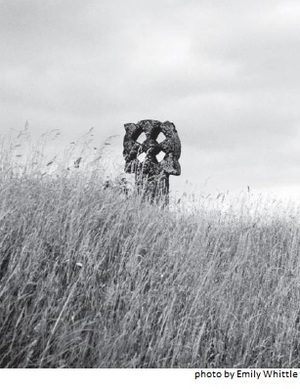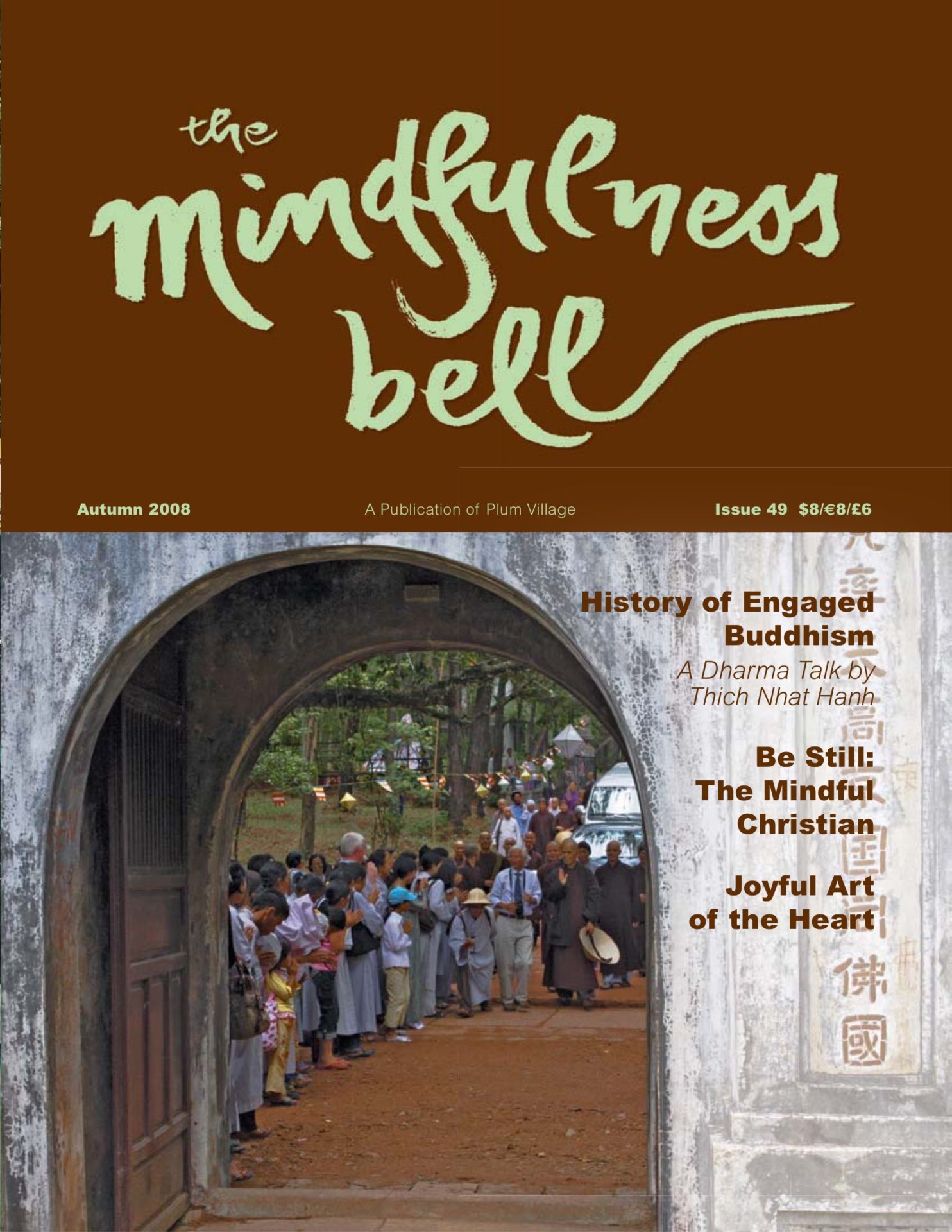The Mindful Christian
By Diane Strausser

We all know the importance of words. Relationships are built with them. Our important teachers use words that help us structure our lives and we carry those words in our minds as we go about the business of living.
Despite the fact that I had been flirting with Buddhist practice for over twenty years, I had not devoted myself with any consistency.
The Mindful Christian
By Diane Strausser

We all know the importance of words. Relationships are built with them. Our important teachers use words that help us structure our lives and we carry those words in our minds as we go about the business of living.
Despite the fact that I had been flirting with Buddhist practice for over twenty years, I had not devoted myself with any consistency. My practice finally began on a spring morning several years ago. I sat in a room of three hundred strangers who had gathered from all parts of the country to experience a day of mindfulness. A diminutive woman gazed out at us from the elevated stage with a very gentle smile on her face. She took her sweet time looking at us and eventually uttered the words, “Welcome, my dear friends.”
The world changed for me with those four simple words. I thought about the possibilities that existed as I considered the strangers in this room to be “dear friends.” What if I went home and thought about my neighbors as “dear friends”? And the grocery store clerk. And people I ran into in my small town. The casual people in my life. Extended family. What if I included the people who had disappointed me to also be “dear friends”? I thought about all of this in the flash of an instant after Anh-Huong Nguyen uttered those words. It was her first Dharma teaching to me. I’m not sure there will ever be a more powerful teaching in my life. I fell in love that morning with the practice of Applied Buddhism.
Teaching Not-Buddhism in a Catholic Church
I took that frame of reference with me when I gave my yearly Lenten presentation to a rural Ohio Catholic church. I am invited each year to speak about creating sacred relationships. My role as a relationship coach and therapist takes me to venues both secular and religious. As I considered what topics I might cover, I struggled with the potential difficulty in sharing the joy of my Buddhist practice with a conservative, Catholic population. My practice is my life and keeping it in the closet is not possible.
Once again, I heard the words of Anh-Huong. In teaching us about community building she reminded us about the importance of compassion. “If people are uncomfortable with a statue of the Buddha, take the statue away.” So, I took the statue away.
“Be still and know that I am God” (Psalm 46:10) became the basis of my presentation to my seriously Catholic friends. I reframed my practice and used their Christian language to teach them how to create peace in their lives so that they could offer it to the world — just as we practice in Applied Buddhism. My focus that night would be as it always is: stopping, calming, and resting which lead to healing and transformation, the principles of the Buddha’s teachings.
That evening I sat in the sanctuary on a step just below the altar. Behind me was a wall of stained glass softly illuminated by the setting sun. Christ hung on a huge cross above me. The parish priest sat with his congregation in the pews facing me, and I began with the words, “Welcome, my dear friends.”
I picked up my singing bell, held it high on my fingertips and let it ring three times. I simply closed my eyes, breathed in and out three times and consciously set the tone for my presentation. My friends looked at me. Confusion filled their faces and I just smiled.
The first thing I taught that night was breath awareness.
“Shhhhh,” I told them. I rang the bell. Hear the bell of God calling...
Now, pay attention to your breath, and as you breathe, think of these words…
Breathing in, I am aware of God calling. Breathing out, I give love.
We talked about the importance of being still enough to hear the voice of God.
Can you hear God’s voice as you wash the dishes?
How about when you’re driving, or waiting in line?
Can you hear God’s voice when somebody disappoints you and you struggle with a response?
The Gift of a Smile
We moved on to giving the gift of a smile.
One of the best ways to relax is to smile. When we smile, it is impossible to be upset. When we smile, our throat relaxes, our cheeks rise and our eyes lift. The muscles of our face send messages to the nerves at the base of our skull. Those nerves send relaxation messages to our brain. Our brain is happy because the signal is sent that communicates, “all-is-well” to the“fight-or-flight” centers. Oxytocin is released in our brain because we are wearing a smile. Oxytocin is the chemical released when a parent cuddles an infant or when lovers hold each other. Oxytocin is the medicine that God gave us to help create compassion and love.
Your smile is a miracle. Your smile has no negative side effects. Your smile is absolutely free. Your smile is a sacred gift to yourself and to others because that one little gesture helps you to make space for the presence of God.
Hear the bell of God calling.
Breathing in, I smile to God.
Breathing out, I smile to my sisters and brothers.
We sat there, looking at each other and smiling. The priest leaned back in the pew with his huge hands resting on top of a friar-like belly, glancing at his people, smiling at them and taking delight in our togetherness. He welcomed my words in front of his pulpit and his smile invited me to keep talking.
Sacred Touch
The practice of sacred hugging was my next topic.
Sharing a physical connection is a sacred act visible in all of God’s creatures. Watch puppies, or lions, or giraffes. Watch the touching that goes on in nature. We human beings are often unconscious about how we touch each other. Being awake, being conscious allows us the pleasure of sacred touch.
Consider offering a very special hug, a sacred hug to the people you love. A sacred hug is not the typical quick leaning into each other and offering a few limp pats on the back. A sacred hug is an act of love given with great tenderness and great generosity.
Follow this recipe for sacred hugging:
Stand facing the other person, making eye contact.
Smile.
Put your hands together over your heart.
Bow to the divine presence of the Holy Spirit in them.
Give them the gift of your smile.
Take three breaths in and out.
Open your arms and embrace the other.
Take three breaths in and out while holding.
Release.
Put your hands together over your heart.
Bow to the divine presence of the Holy Spirit in them.
Say a silent prayer of gratitude for them in your life.
Think about offering a sacred hug to the important people in your life. Then, think about hugging more people. Smile.
The wonderful people of that congregation emptied the pews and spent time giving each other sacred hugs. The farmer hugged his wife and then the blond little girl across from him. The new father cuddled his infant and hugged his mother-in-law with one arm wrapped around her. The priest went from person to person holding them close to his huge body, breathing in and out. The women hugged each other. The men hugged each other. Smiling.
I watched the scene as I held my bell in my lap feeling the joy of this moment. I was deeply moved at the willingness of these quiet, self-contained folks to breathe, smile, and hug. Once again, I understood that no matter what we are or who we are, when the goal is peace we are all the Buddha, or Christ, or Krishna, or Yahweh.
Love Never Fails
No teaching is complete until we talk about loving-kindness. So I read one of the most powerful biblical scriptures:
“Love is patient, love is kind, and is not jealous; love does not brag and is not arrogant, does not act unbecomingly; it does not seek its own, is not provoked, does not take into account a wrong suffered, does not rejoice in unrighteousness, but rejoices with the truth; bears all things, believes all things, hopes all things, endures all things. Love never fails.” (1 Corinthians 13:4-8)
We were created by God to be an example of His love and we are challenged to be visible symbols of that divine love. Transformation is a vehicle that carries us to the Kingdom of God.
Our loving nature allows us to look deeply at our beloved and those around us. The peace in our heart gives us the ability to let go of our misperceptions. We look at others and know that there is deep suffering in them. We are able to be with them without blame, shame, or judgment. As we look deeply and begin to understand the nature of pain in those around us, we are able to be there with them in their place of suffering. We offer them our true presence with love and with kindness.
Loving-kindness is a gentle spirit that whispers healing into the lives of others. Loving-kindness transforms who we are in this very moment.
Hear the bell of God calling.
Breathing in, I feel loving-kindness.
Breathing out, I give love.
As the evening came to an end, a few people hurried off to another meeting. Others came to me with their smile and a desire to hug me. The priest congratulated me and said, “You always teach us such new ways of looking at relationship.” I smiled to myself knowing that what I taught is more than two thousand years old.
My husband and I drove back to the city that night, winding through the quiet country landscape. I was reminded of some of the words in a Christian hymn.
Let there be peace on Earth.
And let it begin with me…
Brothers all are we
Let me walk with my brothers
In perfect harmony.
Let this be the moment now.
That night was a “burning bush” experience for me — a miracle. I shared the most amazing evening with a group of people in a small church in rural Ohio. Despite our differences, there were far more similarities and we were perfectly at ease with each other. I had the privilege of sharing the beauty of my practice. They were open and absorbed my words as they learned how to deepen their Christianity. They were in me and I was in them. Although the world didn’t notice us, I believe that we made things just a bit better for all of us with our smiles, hugs, and mutual breath.
Never once did I utter the “B” word. It just wasn’t the point.
Diane Strausser, Peaceful River of the Heart, practices with Bliss Run Sangha in Columbus, Ohio. She is a therapist, author, and a frequent speaker for both local and national conferences on people and relationships (www.successfulrelationships.com).

